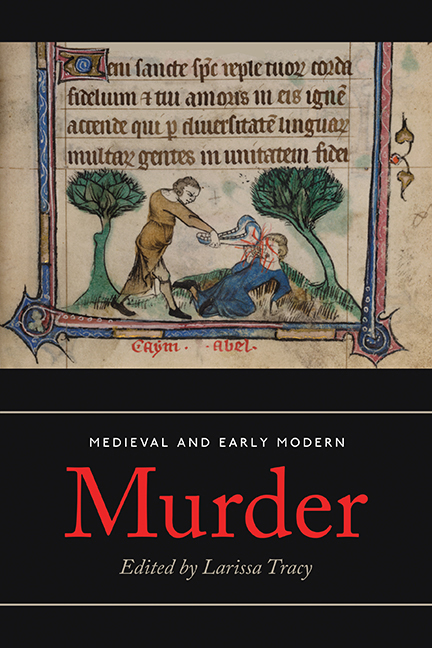Book contents
- Frontmatter
- Contents
- List of Illustrations and Tables
- Acknowledgements
- Contributors
- List of Abbreviations
- Introduction: Murder Most Foul
- I Murder on Trial: Justice, Law and Society
- II The Public Hermeneutics of Murder: Interpretation and Context
- 6 Bringing Murder to Light: Death, Publishing and Performance in Icelandic Sagas
- 7 ‘I Think This Bacon is Wearing Shoes’: Comedy and Murder in the Old French Fabliaux
- 8 ‘Chevaliers ocirre’: Manslaughter, Morality and Meaning in the Queste del Saint Graal
- 9 Murder, Manslaughter and Reputation: Killing in Malory's Le Morte Darthur
- 10 Poisoning as a Means of State Assassination in Early Modern Venice
- 11 Defamation, a Murder More Foul?: The ‘Second Murder’ of Louis, Duke of Orleans (d. 1407) Reconsidered
- 12 ‘A general murther, an universal slaughter’: Strategies of Anti-Jesuit Defamation in Reporting Assassination in the Early Modern Period
- III Murder in the Community: Gender, Youth And Family
- Conclusion
- Select Bibliography
- Index
12 - ‘A general murther, an universal slaughter’: Strategies of Anti-Jesuit Defamation in Reporting Assassination in the Early Modern Period
from II - The Public Hermeneutics of Murder: Interpretation and Context
Published online by Cambridge University Press: 05 July 2018
- Frontmatter
- Contents
- List of Illustrations and Tables
- Acknowledgements
- Contributors
- List of Abbreviations
- Introduction: Murder Most Foul
- I Murder on Trial: Justice, Law and Society
- II The Public Hermeneutics of Murder: Interpretation and Context
- 6 Bringing Murder to Light: Death, Publishing and Performance in Icelandic Sagas
- 7 ‘I Think This Bacon is Wearing Shoes’: Comedy and Murder in the Old French Fabliaux
- 8 ‘Chevaliers ocirre’: Manslaughter, Morality and Meaning in the Queste del Saint Graal
- 9 Murder, Manslaughter and Reputation: Killing in Malory's Le Morte Darthur
- 10 Poisoning as a Means of State Assassination in Early Modern Venice
- 11 Defamation, a Murder More Foul?: The ‘Second Murder’ of Louis, Duke of Orleans (d. 1407) Reconsidered
- 12 ‘A general murther, an universal slaughter’: Strategies of Anti-Jesuit Defamation in Reporting Assassination in the Early Modern Period
- III Murder in the Community: Gender, Youth And Family
- Conclusion
- Select Bibliography
- Index
Summary
IN 1976 THE ASSASSINATION Information Bureau, a citizens’ initiative attempting to mobilise support for renewed investigations into the series of assassinations beginning with Kennedy's murder in 1963, published a collection of essays with the title Government by Gunplay: Assassination Conspiracy Theories from Dallas to Today. This was only the second time that the term ‘conspiracy theory’ had appeared in a book title, and its usage in this case is noteworthy due to the absence of any need felt by the editors to disavow conspiracy theories per se. In the wake of Watergate, with mistrust of official explanations running high, such non-official explanations were enjoying their moment in the sun. More generally, the phenomenon in question justified this attitude; in the initial attempts to understand an assassination, it is perfectly reasonable to countenance the possibility of a conspiracy. Yet it is not necessary even to open the book to catch a glimpse of those slippages in logic and affronts to plausibility that give conspiracy theories their bad reputation. On the back cover of Government by Gunplay, a blurb proclaims that the book explores ‘Links in the Chain of Conspiracy’. Thus, in contrast to the title, which at least leaves open the possibility of a multitude of conspiracies, corresponding to a multitude of assassinations, this statement bears witness to a tendency to concatenate all the smaller conspiracies by positing one singular, all-encompassing conspiracy theory.
This tendency to imagine some broader, more encompassing subversion linking a series of assassinations was not specific to the political culture of the United States in the 1960s and 1970s. It was also at work in the early modern period, a period in which, on more than one occasion, the atmosphere of solemn respect induced by the presence of a dignitary dissolved as a result of a sudden act of violence undertaken by some previously inconspicuous commoner. Of course, every assertion of some commonality between two distinct periods can only be an invitation to refine further the observation by noting the pertinent differences. In this case, a significant point of contrast is discernible in the degree of certainty (or uncertainty) with which those claiming a conspiracy sought to identify and denounce the conspirators.
- Type
- Chapter
- Information
- Medieval and Early Modern MurderLegal, Literary and Historical Contexts, pp. 281 - 308Publisher: Boydell & BrewerPrint publication year: 2018

